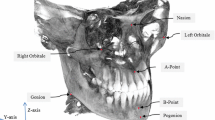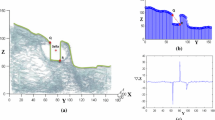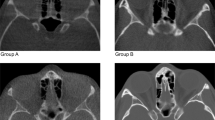Abstract
Purpose
Nowadays, with the increased diffusion of Cone Beam Computerized Tomography (CBCT) scanners in dental and maxillo-facial practice, 3D cephalometric analysis is emerging. Maxillofacial surgeons and dentists make wide use of cephalometric analysis in diagnosis, surgery and treatment planning. Accuracy and repeatability of the manual approach, the most common approach in clinical practice, are limited by intra- and inter-subject variability in landmark identification. So, we propose a computer-aided landmark annotation approach that estimates the three-dimensional (3D) positions of 21 selected landmarks.
Methods
The procedure involves an adaptive cluster-based segmentation of bone tissues followed by an intensity-based registration of an annotated reference volume onto a patient Cone Beam CT (CBCT) head volume. The outcomes of the annotation process are presented to the clinician as a 3D surface of the patient skull with the estimate landmark displayed on it. Moreover, each landmark is centered into a spherical confidence region that can help the clinician in a subsequent manual refinement of the annotation. The algorithm was validated onto 18 CBCT images.
Results
Automatic segmentation shows a high accuracy level with no significant difference between automatically and manually determined threshold values. The overall median value of the localization error was equal to 1.99 mm with an interquartile range (IQR) of 1.22–2.89 mm.
Conclusion
The obtained results are promising, segmentation was proved to be very robust and the achieved accuracy level in landmark annotation was acceptable for most of landmarks and comparable with other available methods.




Similar content being viewed by others
References
Gateno J, Xia JJ, Teichgraeber JF (2011) New 3-dimensional cephalometric analysis for orthognathic surgery. J Oral Maxillofac Surg 69:606–622. doi:10.1016/j.joms.2010.09.010
Bettega G, Payan Y, Mollard B, Boyer A, Raphael B, Lavallèe S (2000) A simulator for maxillofacial surgery integrating 3D cephalometry and orthodontia. Comput Aided Surg 5:156–165
Hurst CA, Eppley BL, Havlik RJ, Sadove AM (2007) Surgical cephalometrics: applications and developments. Plast Reconstr Surg 120:92e–104e. doi:10.1097/01.prs.0000282728.97278.a2
Pittayapat P, Limchaichana-Bolstad N, Willems G, Jacobs R (2014) Three-dimensional cephalometric analysis in orthodontics: a systematic review. Orthod Craniofac Res 17:69–91. doi:10.1111/ocr.12034
Swennen GRJ, Schutyser F (2006) Three-dimensional cephalometry: spiral multi-slice vs cone-beam computed tomography. Am J Orthod Dentofacial Orthop 130:410–416. doi:10.1016/j.ajodo.2005.11.035
Al-Okshi A, Lindh C, Salé H, Gunnarsson M, Rohlin M (2015) Effective dose of cone beam CT (CBCT) of the facial skeleton: a systematic review. Br J Radiol 88:20140658. doi:10.1259/bjr.20140658
Weissheimer A, Menezes LM, Koerich L, Pham J, Cevidanes LHS (2015) Fast three-dimensional superimposition of cone beam computed tomography for orthopaedics and orthognathic surgery evaluation. Int J Oral Maxillofac Surg 44:1188–1196. doi:10.1016/j.ijom.2015.04.001
Sun Y, Luebbers H-T, Agbaje JO, Schepers S, Vrielinck L, Lambrichts I, Politis C (2013) Validation of anatomical landmarks-based registration for image-guided surgery: an in-vitro study. J Cranio-Maxillo-Facial Surg 41:522–526
Swennen GRJ, Schutyser F, Barth E-L, De Groeve P, De Mey A (2006) A new method of 3-D cephalometry part I: the anatomic cartesian 3-D reference system. J Craniofac Surg 17:314–325
Titiz I, Laubinger M, Keller T, Hertrich K, Hirschfelder U (2011) Repeatability and reproducibility of landmarks—a three-dimensional computed tomography study. Eur J Orthod 34:1–11. doi:10.1093/ejo/cjq190
Katkar RA, Kummet C, Dawson D, Moreno Uribe L, Allareddy V, Finkelstein M, Ruprecht A (2013) Comparison of observer reliability of three-dimensional cephalometric landmark identification on subject images from Galileos and i-CAT cone beam CT. Dentomaxillofacial Radiol 42:1–11. doi:10.1259/dmfr.20130059
Cheng Y, Leow WK (2012) Automatic identification of frankfurt plane and mid-sagittal plane of skull. IEEE Work Appl Comput Vis 2012:233–238. doi:10.1109/WACV.2012.6162994
Keustermans J, Mollemans W, Vandermeulen D, Suetens P (2010) Automated cephalometric landmark identification using shape and local appearance models. In: IEEE 20th International conference on pattern recognition, pp 2464–2467
Keustermans J, Smeets D, Vandermeulen D, Suetens P (2011) Automated cephalometric landmark localization using sparse shape and appearance models. In: International workshop on machine learning medical imaging. Springer, Berlin Heidelberg, pp 249–256
Wang L, Chen KC, Gao Y, Shi F, Liao S, Li G, Shen SGF, Yan J, Lee PKM, Chow B, Liu NX, Xia JJ, Shen D (2014) Automated bone segmentation from dental CBCT images using patch-based sparse representation and convex optimization. Med Phys 41:043503. doi:10.1118/1.4868455
Shahidi S, Bahrampour E, Soltanimehr E, Zamani A, Oshagh M, Moattari M, Mehdizadeh A (2014) The accuracy of a designed software for automated localization of craniofacial landmarks on CBCT images. BMC Med Imaging 14:32. doi:10.1186/1471-2342-14-32
Makram M, Kamel H (2014) Reeb graph for automatic 3D cephalometry. Int J Image Process 8:17–29
Gupta A, Kharbanda OP, Sardana V, Balachandran R, Sardana HK (2015) A knowledge-based algorithm for automatic detection of cephalometric landmarks on CBCT images. Int J Comput Assist Radiol Surg 10:1737–1752. doi:10.1007/s11548-015-1173-6
de Oliveira AEF, Cevidanes LHS, Phillips C, Motta A, Burke B, Tyndall D (2009) Observer reliability of three-dimensional cephalometric landmark identification on cone-beam computerized tomography. Oral Surg Oral Med Oral Pathol Oral Radiol Endod 107:256–265. doi:10.1016/j.tripleo.2008.05.039
Swennen GRJ, Schutyser F, Hausamen JE (2005) Three-dimensional cephalometry: a color atlas and manual. Springer Science & Business Media, Berlin
Sagawa M, Miyoseta Y, Hayakawa Y, Honda A (2009) Comparison of two- and three-dimensional filtering methods to improve image quality in multiplanar reconstruction of cone-beam computed tomography. Oral Radiol 25:154–158. doi:10.1007/s11282-009-0026-9
Hassan B, Souza PC, Jacobs R, de Azambuja Berti S, van der Stelt P (2010) Influence of scanning and reconstruction parameters on quality of three-dimensional surface models of the dental arches from cone beam computed tomography. Clin Oral Investig 14:303–310. doi:10.1007/s00784-009-0291-3
Pham DL, Xu C, Prince JL (2000) Current methods in medical image segmentation 1. Annu Rev Biomed Eng 2:315–337
Ng HP, Ong SH, Foong KWC, Goh PS, Nowinski WL (2006) Medical image segmentation using K-means clustering and improved watershed algorithm. In: 2006 IEEE southwest symposium on image analysis and interpretation pp 61–65
MacKay DJ (2003) Information theory, inference and learning algorithms. Cambridge University Press, Cambridge
Gao Y, Zhan Y, Shen D (2014) Incremental learning with selective memory (ILSM): towards fast prostate localization for image guided radiotherapy yaozong. IEEE Trans Med Imaging 33:518–534. doi:10.1109/TMI.2013.2291495
Liu J, Gao W, Huang S, Nowinski WL (2008) A model-based, semi-global segmentation approach for automatic 3-D point landmark localization in neuroimages. IEEE Trans Med Imaging 27:1034–1044. doi:10.1109/TMI.2008.915684
Frantz S, Rohr K, Stiehl HS (2000) Localization of 3D anatomical point landmarks in 3D tomographic images using deformable models. In: International conference on medical image computing and computer-assisted intervention 2000. Springer Berlin Heidelberg, pp 492–501
Hill DL, Batchelor PG, Holden M, Hawkes DJ (2001) Medical image registration. Phys Med Biol 46:R1–R45
Myronenko A, Song X (2010) Intensity-based image registration by minimizing residual complexity. IEEE Trans Med Imaging 29:1882–1891
Rueckert D, Sonoda LI, Hayes C, Hill DL, Leach MO, Hawkes DJ (1999) Nonrigid registration using free-form deformations: application to breast MR images. IEEE Trans Med Imaging 18:712–721. doi:10.1109/42.796284
Baan F, Liebregts J, Xi T, Schreurs R, de Koning M, Bergé S, Maal T (2016) A new 3D tool for assessing the accuracy of bimaxillary surgery: the orthognathic analyser. PLoS One 11:e0149625. doi:10.1371/journal.pone.0149625
Puisoru M, Forna N, Fatu A, Fuatu R, Fuatu C (2006) Analysis of mandibular variability in humans of different geographic areas. Ann Anatomy-Anatomischer Anzeiger 188:547–554
Schlicher W, Nielsen I, Huang JC, Maki K, Hatcher DC, Miller AJ (2012) Consistency and precision of landmark identification in three-dimensional cone beam computed tomography scans. Eur J Orthod 34:263–275. doi:10.1093/ejo/cjq144
Author information
Authors and Affiliations
Corresponding author
Ethics declarations
Conflict of interest
Marina Codari, Matteo Caffini, Chiarella Sforza, Gianluca M. Tartaglia and Giuseppe Baselli declare that they have no conflict of interest.
Staement of human rights
For this type of study, formal consent is not required.
Informed consent
Informed consent was obtained from all patients for being included in the study. The study was approved by the Institutional Review Board of the SST Dental Clinic (IRB03-2015 Doc. MQ 03 AL 02-MC).
Rights and permissions
About this article
Cite this article
Codari, M., Caffini, M., Tartaglia, G.M. et al. Computer-aided cephalometric landmark annotation for CBCT data. Int J CARS 12, 113–121 (2017). https://doi.org/10.1007/s11548-016-1453-9
Received:
Accepted:
Published:
Issue Date:
DOI: https://doi.org/10.1007/s11548-016-1453-9





